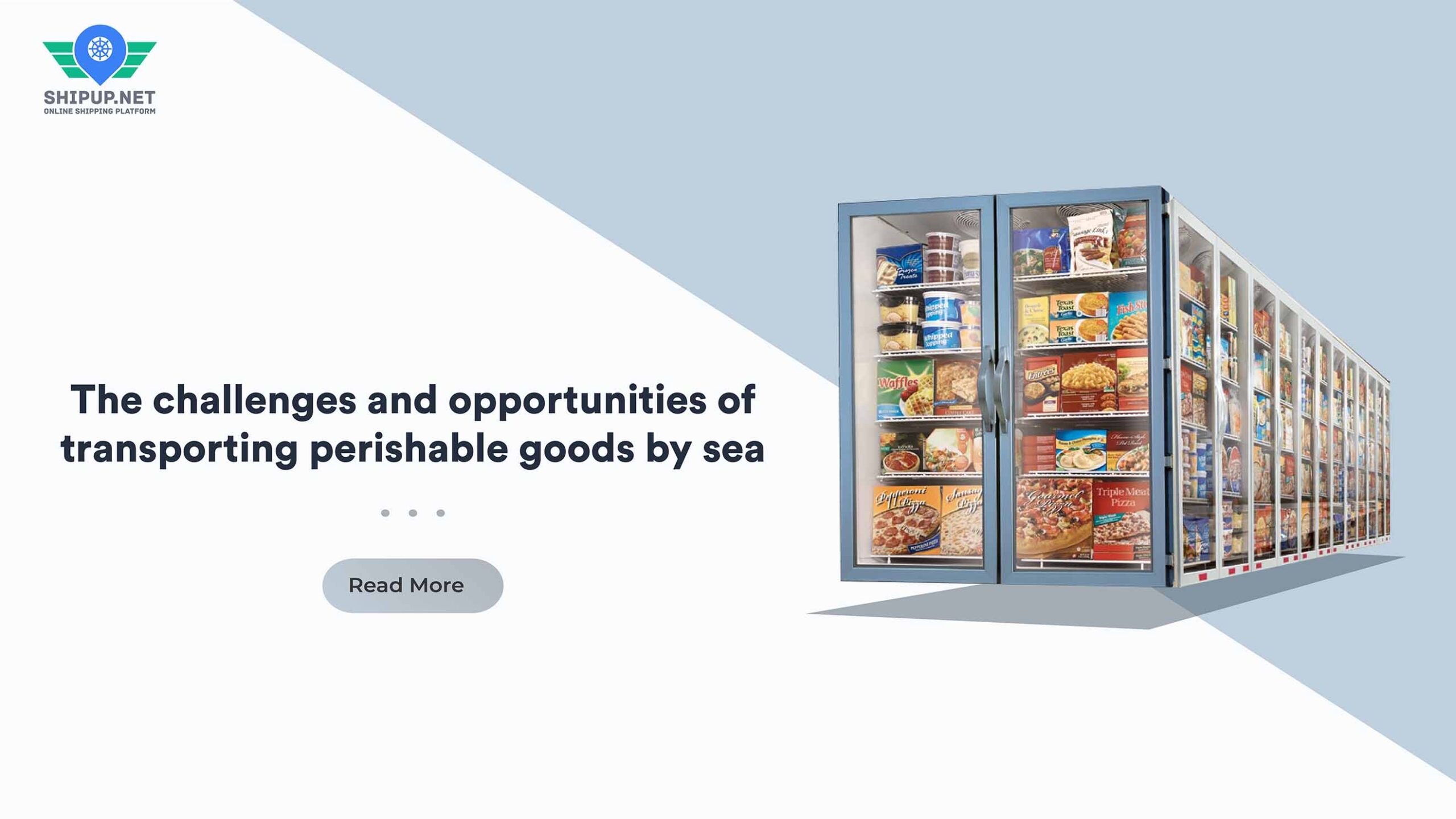Transporting perishable goods is crucial for keeping the global food supply chain intact, ensuring that fresh produce, dairy, meat, and other perishables reach their destinations in a timely and safe manner. One of the most important modes of transportation for these goods is through sea transport.
Sea transportation has long been a reliable and efficient method of shipping perishables around the world. With the growth of the global economy, it has become increasingly important to transport goods quickly and safely. The importance of sea transport for perishable goods cannot be overstated, as it provides access to far-reaching markets and allows for efficient delivery to major population centers.
However, the process of transporting perishable goods by sea presents several unique challenges. These challenges range from the maintenance of the appropriate temperature controls to tracking the shipment’s location and temperature throughout transit. In addition to these challenges, there are also great opportunities for those in the industry to innovate and improve the way perishable goods are transported by sea.
In this article, we will explore the challenges and opportunities of transporting perishable goods by sea. We will examine the steps involved in transporting perishables by sea, and discuss the ways in which the industry is responding to these challenges. By the end of this article, you will have a deeper understanding of the complexities of transporting perishables by sea, and the opportunities available for those who are up to the challenge.
Opportunities of transporting perishable goods by sea
Transporting perishable goods by sea presents significant opportunities for reducing spoilage and waste, improving environmental sustainability, and enhancing supply chain efficiency.
Reduced spoilage and waste
Perishable goods are susceptible to spoilage and waste during transportation, especially when they are shipped over long distances. However, sea transportation provides a stable environment with consistent temperature and humidity levels, reducing the risk of spoilage and waste. Additionally, advances in technology have led to the development of specialized containers with temperature-controlled systems that further minimize spoilage and waste.
According to a report by the United Nations Conference on Trade and Development (UNCTAD), up to 40% of perishable goods can be lost during transportation. However, using sea transportation with specialized containers can reduce this loss to less than 5%, resulting in significant savings for businesses.
One example of a solution for reducing spoilage and waste during sea transportation is the use of refrigerated containers that maintain a specific temperature range throughout the journey. Another example is the use of modified atmosphere packaging (MAP), which creates a protective environment around the product to prevent spoilage.
Improved supply chain efficiency
Efficiency is critical to any supply chain, and the transportation of perishable goods is no exception. By streamlining processes, businesses can reduce costs and decrease waste. Shipping by sea offers several opportunities to improve supply chain efficiency, including:
Shipping by sea allows for larger volumes of goods to be transported in a single shipment. The use of larger ships optimized for the transport of perishable goods, can further reduce costs by increasing economies of scale. Additionally, with advances in technology, shipping companies can now offer real-time tracking of cargo, allowing businesses to monitor the status of their goods and adjust their supply chain as necessary.
According to a report by the World Bank, increasing supply chain efficiency can lead to significant cost savings and waste reduction. In the food and beverage industry, for example, a 10% reduction in supply chain waste can result in a 5% increase in profitability. Additionally, by reducing waste and improving efficiency, companies can minimize their environmental impact and contribute to a more sustainable future.
Examples of solutions:
1- One solution for improving supply chain efficiency is the use of real-time monitoring systems that provide businesses with real-time visibility into their supply chain. This approach helps businesses to identify and mitigate any issues that may arise during transportation, improving the reliability of the supply chain. Additionally, utilizing advanced analytics and data-driven insights can help to optimize logistics and reduce the time and cost associated with transportation. Using Visiwise you can automatically get updates on you perishable goods and see them in a separate view that only shows you the shipments with Persishable tag.
Challenges of transporting perishable goods by sea
Despite the opportunities that come with transporting perishable goods by sea, there are also significant challenges that must be addressed to ensure that goods arrive at their destination in good condition. Some of these challenges include:
A. Temperature control and monitoring
Maintaining proper temperature control during transport is essential to prevent spoilage and ensure product quality. However, temperature fluctuations can occur due to a range of factors, including equipment malfunction, power outages, and changes in weather conditions. To address this challenge, many shippers use advanced monitoring systems that can track temperature and humidity in real-time, enabling them to make adjustments as needed to maintain optimal conditions.
B. Packaging and handling
Proper packaging and handling are crucial for preserving the quality of perishable goods during transportation. However, different types of products require different handling and packaging methods, which can be complex and expensive. For example, seafood must be packaged and stored on ice, while fruits and vegetables may require specialized containers and packaging materials.
C. Logistics and transportation infrastructure
Efficient transportation infrastructure is critical to ensuring that perishable goods are transported quickly and efficiently. However, many regions lack the necessary infrastructure, including cold storage facilities, transportation networks, and customs clearance procedures, to support the transportation of perishable goods. This can result in delays and additional costs, which can impact product quality and increase the risk of spoilage.
Improved Supply Chain Efficiency
Efficiency is critical to any supply chain, and the transportation of perishable goods is no exception. By streamlining processes, businesses can reduce costs and decrease waste. Shipping by sea offers several opportunities to improve supply chain efficiency, including:
1- Explanation of opportunity
Shipping by sea allows for larger volumes of goods to be transported in a single shipment. The use of larger ships, optimized for the transport of perishable goods, can further reduce costs by increasing economies of scale. Additionally, with advances in technology, shipping companies can now offer real-time tracking of cargo, allowing businesses to monitor the status of their goods and adjust their supply chain as necessary.
2-Statistics on the impact of improved efficiency on cost and waste
According to a report by the World Bank, increasing supply chain efficiency can lead to significant cost savings and waste reduction. In the food and beverage industry, for example, a 10% reduction in supply chain waste can result in a 5% increase in profitability. Additionally, by reducing waste and improving efficiency, companies can minimize their environmental impact and contribute to a more sustainable future.
3- Examples of solutions
One solution for improving supply chain efficiency in the shipping of perishable goods is the use of specialized containers. These containers can maintain a constant temperature and humidity level, ensuring that the goods remain fresh and intact throughout the entire journey. Additionally, shipping companies can work with customers to optimize shipping schedules and routes, reducing transit times and improving overall efficiency.
Overall, the transportation of perishable goods by sea offers numerous opportunities for reducing waste, improving efficiency, and contributing to a more sustainable future. By taking advantage of these opportunities, businesses can increase profitability, reduce their environmental impact, and meet the growing demand for fresh, high-quality products.
Keep Your Perishable Goods in Sight with Visiwise Visibility Platform
Transporting perishable goods by sea can be a daunting task, as it involves many uncertainties that can affect the quality and safety of the cargo. However, with the right tools and technologies, importers, exporters, and freight forwarders can ensure that their shipments are always under control and visible.
That’s where the Visiwise Visibility platform comes in. This powerful solution provides real-time tracking and monitoring of your shipments, enabling you to anticipate and manage exceptions and movements that require your attention. With Visiwise, you can stay informed about your perishable goods’ whereabouts and conditions and take proactive measures to prevent spoilage and waste.
RA INTERNATIONAL was one our clients who used our Map Veiw feature on a big display in their office. Their refregerated shipments have a different logo, making them easy to find on the map.
Visiwise offers a range of features and benefits that can help you optimize your supply chain and enhance your customer experience. For instance, you can set up alerts and notifications to receive updates on your shipments’ status, create customized tracking pages to share with your clients, and leverage data analytics to gain insights into your operations’ performance.
By using Visiwise, you can also benefit from its integrations with various carriers and logistics providers, which enable you to consolidate your shipping data and simplify your workflow. With a user-friendly and intuitive interface, Visiwise makes it easy to manage your shipments and collaborate with your partners all in one place.
In short, Visiwise is a game-changer for anyone involved in transporting perishable goods by sea. It gives you the visibility and control you need to ensure your cargo arrives at its destination safely and on time while also improving your operational efficiency and customer satisfaction.


